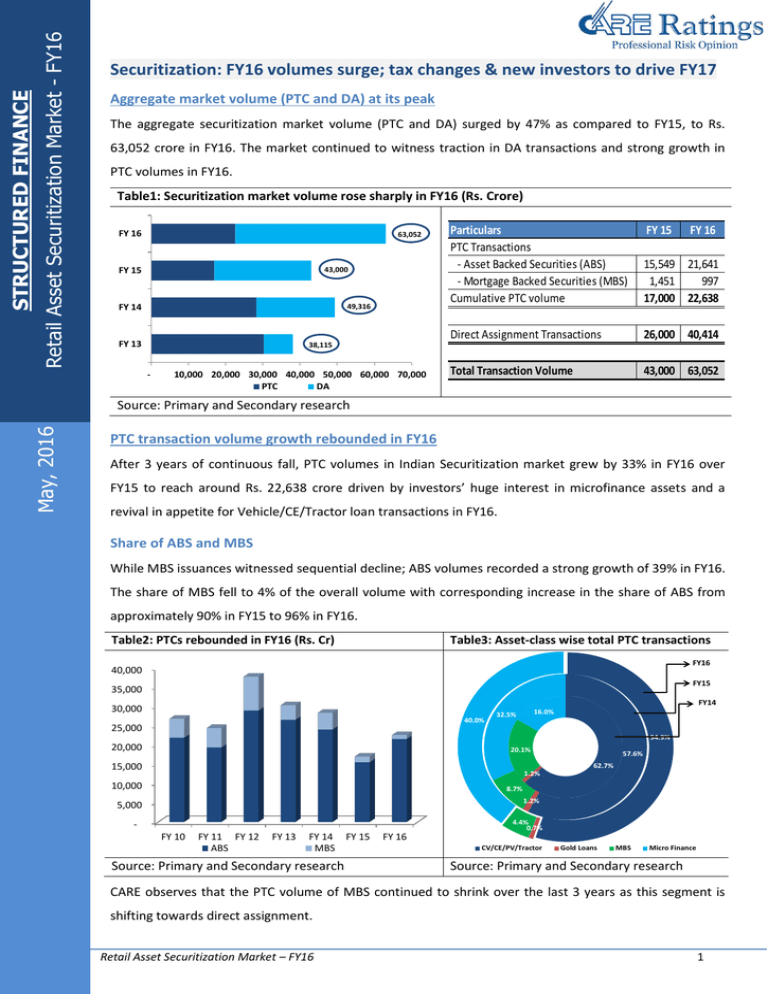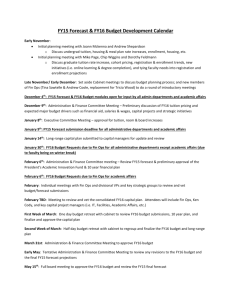Securitization: FY16 volumes surge; tax changes & new investors to... Aggregate market volume (PTC and DA) at its peak
advertisement

Retail Asset Securitization Market - FY16 Aggregate market volume (PTC and DA) at its peak The aggregate securitization market volume (PTC and DA) surged by 47% as compared to FY15, to Rs. 63,052 crore in FY16. The market continued to witness traction in DA transactions and strong growth in PTC volumes in FY16. Table1: Securitization market volume rose sharply in FY16 (Rs. Crore) FY 16 63,052 FY 15 43,000 FY 14 49,316 FY 13 Particulars PTC Transactions - Asset Backed Securities (ABS) - Mortgage Backed Securities (MBS) Cumulative PTC volume FY 15 FY 16 15,549 21,641 1,451 997 17,000 22,638 Direct Assignment Transactions 26,000 40,414 Total Transaction Volume 43,000 63,052 38,115 - 10,000 20,000 30,000 40,000 50,000 60,000 70,000 PTC DA Source: Primary and Secondary research May, 2016 STRUCTURED FINANCE Securitization: FY16 volumes surge; tax changes & new investors to drive FY17 PTC transaction volume growth rebounded in FY16 After 3 years of continuous fall, PTC volumes in Indian Securitization market grew by 33% in FY16 over FY15 to reach around Rs. 22,638 crore driven by investors’ huge interest in microfinance assets and a revival in appetite for Vehicle/CE/Tractor loan transactions in FY16. Share of ABS and MBS While MBS issuances witnessed sequential decline; ABS volumes recorded a strong growth of 39% in FY16. The share of MBS fell to 4% of the overall volume with corresponding increase in the share of ABS from approximately 90% in FY15 to 96% in FY16. Table2: PTCs rebounded in FY16 (Rs. Cr) Table3: Asset-class wise total PTC transactions FY16 40,000 FY15 35,000 FY14 30,000 40.0% 25,000 16.0% 32.5% 54.9% 20,000 20.1% 15,000 57.6% 62.7% 1.2% 10,000 8.7% 1.2% 5,000 4.4% 0.7% FY 10 FY 11 FY 12 ABS FY 13 FY 14 FY 15 MBS Source: Primary and Secondary research FY 16 CV/CE/PV/Tractor Gold Loans MBS Micro Finance Source: Primary and Secondary research CARE observes that the PTC volume of MBS continued to shrink over the last 3 years as this segment is shifting towards direct assignment. Retail Asset Securitization Market – FY16 1 Structured Finance MFI PTC volume gain prominence, MFI’s converting into SFBs to limit growth MFI PTC volumes surged by 67% in FY16, as compared to 20% in FY15. As MFI loans qualify under ‘agriculture’ and ‘weaker sections’ categories of PSL, it has emerged as preferred asset class for bankers to meet their PSL targets. Further, MFIs have demonstrated superior performance in asset quality. The share of MF loan portfolio in aggregate securitization volume jumped from 32.5% in FY15 to 40.0% in FY16. RBI has given in-principle approval to ten entities for conversion in to Small Finance Banks (SFBs) before March 2017, out of which eight are microfinance entities. These eight MFIs accounted for 45% of the total microfinance industry loan portfolio as on Dec’15. Out of these eight microfinance entities, six microfinance entities have sold a portfolio worth of Rs. 4,162 crore in FY16 representing 46% of total MFI PTC volume. As the entities convert into SFBs, they can avail other options of leveraging their microfinance assets through IBPCs (for raising funds) and PSLCs. However, the proportion in which SFBs would use securitization, PSLCs and IBPCs would depend on many factors such as profitability, balance sheet growth, and deposit mobilisation & tenure of deposits raised. Additionally, using PSLCs would largely depend on the fee of the PSLC and the premium offered by the market at the time of issue. CARE is of the view that microfinance PTCs issuance by existing market players (who continue to remain NBFC-MFI) would post healthy growth, but declining PTC issuance by new SFBs (erstwhile NBFC-MFIs) would result in slower overall microfinance PTC growth in FY17 as against FY16. The share of other asset classes (i.e. Vehicle and Gold loans) have reported continuous decline during FY15 & FY16. Despite reporting a y-o-y growth of 29% in FY16, the share of Vehicle loans (i.e. CV/CE/Tractor/PV etc.) declined to 55% in FY16 from 58% in FY15. The Commercial Vehicle (CV), Construction Equipment (CE), Passenger Vehicle (PV) and Tractor segment reported PTC transactions of about Rs. 12,424 crore in FY16. DA volumes: soaring to a new high in FY16 PSU banks have been active purchaser of retail loan pool as it helped them 1) expand their loan book, 2) meet PSL target, and 3) enhance the proportion of better quality loans in their portfolio. As per CARE estimates, the volume of Direct Assignment (DA) transactions grew by whopping 55% in FY16 over last fiscal year to Rs. 40,500 crore. Table4: DA continues to dominate securitization volume Table5: Mortgages dominate DA segments (FY16) FY16 FY15 5% FY14 17% 36% 40% 43% 57% 60% 64% 78% PTC DA Source: Primary and Secondary research Retail Asset Securitization Market - FY16 CV/CE/PV/Tractor MBS Micro Finance Source: Primary research 2 Structured Finance As banks draw comfort from well-seasoned portfolio and better credit profile loan contracts from NBFCs/HFCs, the share of bilateral retail loan pool assignments (i.e. direct assignment) increased to 64% of the overall market volume (PTC and DA) in FY16 from 60% in FY15. On the other hand, NBFCs/HFCs have several benefits from DAs, such as 1) capital savings on pools assigned bilaterally, 2) diversification of avenues of funding for originators, and 3) collection / servicing fee received from pools securitised, boosting their non-interest income. Further, securitization gives NBFCs/HFCs the option to expand their portfolio faster with existing funds and infrastructure. CARE is of the view that the PSU banks’ appetite towards DA would largely hinge on the performance of previous DA transactions and extent of revival in corporate credit. Regulatory Updates PSLC Guidelines RBI released the guidelines on Priority Sector Lending Certificates (PSLCs) under which banks can buy and sell the PSLC of Scheduled Commercial Banks (SCBs), Regional Rural Banks (RRBs), Local Area Banks (LABs), Small Finance Banks (SFBs) and Urban Co-operative Banks (UCBs) to achieve the priority sector lending target and sub-targets. It will be in the lot size of Rs. 25 lakh which would be traded for fee/premium. All the PSLCs sold/bought will not be valid after 31st March every year irrespective of the date of sold/bought during the year. As per guidelines, they can issue certificate up to 50% of last years’ PSL achievement. This opens up the possibility for specialised SCBs and SCBs with surplus PSL advances to issue PSLCs by leveraging their portfolio. Further the NBFC-MFIs converting in to SFBs would seek advantage of their existing PSL qualifying portfolio to issue PSLCs. Table6: SCBs, UCBs & RRBs scope for PSLCs trading (Rs. bn) as on FY15 Outstanding Advances PSL Advances - Agri - Non-Agri PSL Target - Agri - Non-Agri PSL Advances excess/shortfall SCBs 6,142,329 2,022,233 770,030 1,252,203 2,456,932 1,105,619 1,351,312 (434,699) RRBs 177,940 144,664 98,085 46,579 133,455 32,029 101,426 11,208 UCBs 224,329 110,821 5,550 105,271 89,731 89,731 21,090 Source: RBI & Ministry of Finance Reports As per available data, UCBs have Rs. 5500 crore of agri-PSL advances and Rs. 15,539 crore of excess non-agriPSL advances as of FY15. As UCBs have no specific agri segment target and have not been expressly allowed recourse to IBPCs, the entire agri & excess non-agri portfolio of UCBs would be available for PSLCs issuance. CARE opines that the present volume of IBPCs will not be affected significantly as RRBs would continue to prefer IBPCs transaction for yearly balance sheet growth. CARE observes that UCBs and RRBs have around Rs. 32,298 crore excess PSL advances cumulatively as against a shortfall of Rs. 4,35,000 crore for SCBs as on March 15. The excess may increase, should the UCBs and RRBs make use of the option to issue PSLCs against “50% of Retail Asset Securitization Market - FY16 3 Structured Finance last years’ PSL achievement” in the current year. However, the shortfall of PSL in the books of SCBs is enormous; making securitization (PTC or DA) indispensible for achieving the PSL target. Budget 2016-17: Clarity on Tax provisions & permitting FPIs to invest in PTCs Budget 2013-14 had imposed tax on distribution of income by securitization trusts, leading to reduction of yields. However, Budget 2016-17 has provided ‘complete pass-through’ status of income tax for securitization trusts. The income earned through securitization would be taxable in the hands of the investor. Though provisions of Tax Deducted at Source (TDS) / withholding tax would apply to such income transferred by trusts, income tax credit for the same would be allowed. Budget 2016-17 has also added ‘unlisted debt securities and Pass Through Securities issued by securitization SPVs’ to the list of eligible investible debt securities for Foreign Portfolio Investors (FPIs). Earlier, FPIs were permitted to invest only in G-secs, CPs, debt securities of infrastructure sector, and Security receipts issued by ARCs. In addition, the government has removed the distinction between Foreign Institutional Investors (FIIs) and FPIs for tax purposes. It has relaxed many tax regulations including those with respect to General AntiAvoidance Rules and Permanent Establishment status. In theory, this could increase the volume of PTC transactions; bring more liquidity and investors such as Mutual Funds, Provident and Pension Funds and Insurance companies. It would aid the issuance of non-PSL PTCs, with market-determined yields. However, there are practical matters that merit the attention of the securitization industry before the changes can be operationalized. Issues such as foreign exchange conversion, premature exit through an active secondary market, withholding tax on interest and double taxation avoidance await clarity from relevant regulatory authorities. Outlook The conversion of NBFC-MFIs into SFBs, and availability of alternate avenues such as IBPCs and PSLCs for meeting PSL requirements may impact the securitization volume. However, SCBs’ enormous appetite for PSL assets (as against insufficient PSL assets in books of RRBs and UCBs) and the entry of new investors (Foreign Portfolio Investors, Mutual Funds, Pension & Provident Funds, and Insurance Companies) into securitization market would augur well for the industry. Contact: Vijay Agrawal Joint General Manager Ramadasu Bandaru Sr. Manager Mukund Upadhyay Manager vijay.agrawal@careratings.com ramadasu.bandaru@careratings.com mukund.upadhyay@careratings.com 91-22-67543416 91-22-6754 3402 91-22-6754 3669 Disclaimer This report is prepared by Credit Analysis & Research Limited [CARE]. CARE has taken utmost care to ensure accuracy and objectivity while developing this report based on information available in public domain. However, neither the accuracy nor completeness of information contained in this report is guaranteed. CARE is not responsible for any errors or omissions in analysis/inferences/views or for results obtained from the use of information contained in this report and especially states that CARE (including all divisions) has no financial liability whatsoever to the user of this report. Retail Asset Securitization Market - FY16 4
